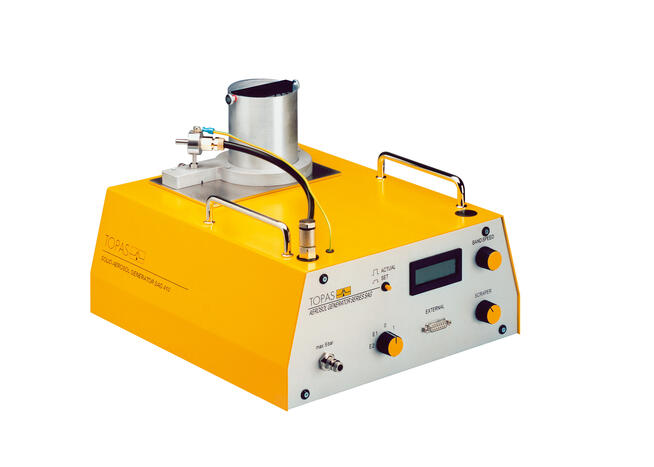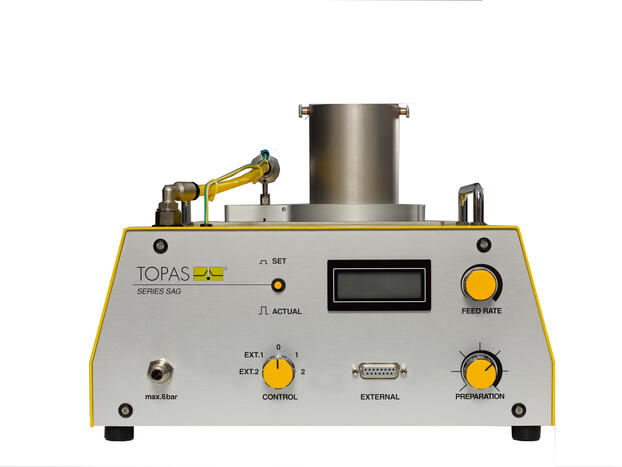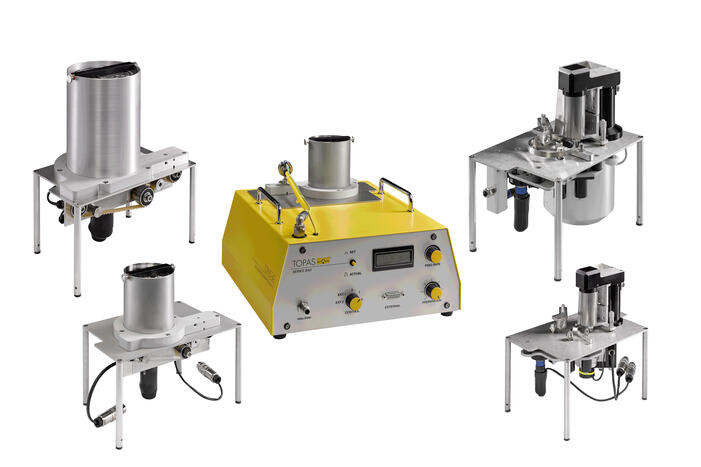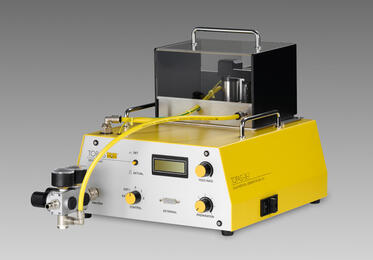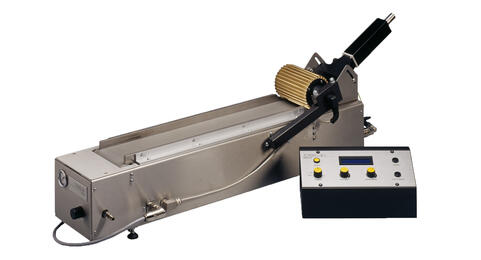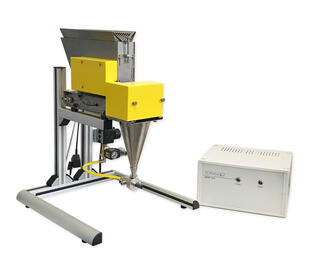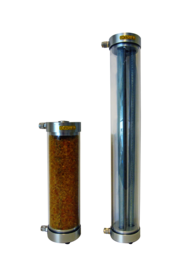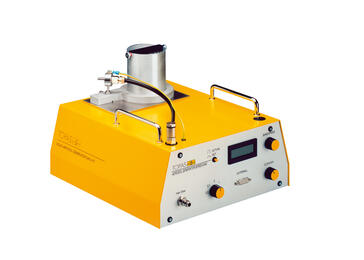SAG 410 Dust Generator
Solid Aerosol Generator SAG 410 for aerosol generation from powders, toothed belt dosing, moderate mass flow rates
The modular design enables the user to realise a wide range of powder mass flows. The fine adjustment of the powder mass flow is done by a comfortable infinitely variable control of the belt speed. Finally, the powder is transported by suction from the dosing belt and dispersed using a two-component nozzle (designed in accordance with ISO 5011).
In case poor-flowing powders such as Pural NF are used for the generation of aerosols, the dust generators SAG 410/U or SAG 410/P are suitable. The transport of the solid material is performed by a feed screw and dosing ring. If the used solid material also tends to adhere to surfaces, the use of a special nozzle (P-nozzle) ensures the suction of the solid material from the dosing ring.
Standards
download
product sheet SAG 410Benefits
- constant powder dosing over time due to speed control
- modular concept for combining a control unit with different dosing and dispersing units
- constant and reproducible feed rate over a wide range – suitable for many applications
- highly accurate, user-independent metering of the powder
- simple interchangeable dispersing units allow a single instrument to have an enormous mass output range
- easy to clean and change material
- remote control units for both manual or computer control are available
- high concentration even at small flow rates – speeds up testing in low flow applications
- refillable during operation without any effect on the aerosol concentration – ideal for long term studies
- convenient unit control
- flexible use and simple operation
Applications
- filter efficiency measurement of filter media and other separators
- aerosol resaerch
- optimization of combustion processes
- mixing and coating processes (e.g. within ceramics technology)
- inhalation and toxicology studies
- flow visualisation, LDV and PIV applications
The generator models SAG 410, SAG 410/L and SAG 410/H, SAG 410/M, SAG 410/V use the same principle of feeding the powder by a special feeding belt. The defined segments warrant a constant and reproducible supply of the powder even in small quantities. The resulting particle number concentration of the output aerosol can be easily adjusted by setting the feeding belt speed over a wide range.
Filling the small segments is realized by the scraper. Its design enables a constant dosing of the powder that is nearly independent of the powder reservoir filling level. The reservoir can be refilled during operation without any effects on the aerosol concentration.
The dispersing unit consist of a dual-stream ejector nozzle (similar to DIN ISO 5011) and a tube connection to the housing for compressed air supply. Shear forces created in this ejector disperse and deagglomerate the powder to form an aerosol.
| Parameter title | Unit | Value |
|---|---|---|
| setting parameter 1 | - | dispersion pressure |
| setting range 1 | bar | 1 ... 6 (dispersion pressure) |
| setting resolution 1 | - | continously adjustable |
| setting parameter | - | relative belt velocity |
| setting range 2 | % | |
| setting resolution | % | 0,1 |
| setting parameter 3 | - | relative stirring frequency |
| setting range 3 | % | 0 ... 100 (relative stirring frequency) |
| setting resolution 3 | - | continously adjustable |
| aerosol, volumetric flow rate | L/h | 1500 ... 4000 |
| aerosol, mass flow rate (aerosol substance) | g/h | 5 ... 500 |
| operating medium, gas/air | - | dry, particle-free compressed air or technical inert gas |
| operating medium, gas/air - compressed air supply | bar | 1 ... 6 |
| operating medium, aerosol substance | - | powder, powder mixtures (< 200 µm) |
| operating medium, aerosol substance - filling volume | mL | ≤ 400 |
| power supply | - | 100 ... 260 V AC, 47 ... 63 Hz |
| dimensions (w × h × d) | mm | 330 × 260 × 360 |
| weight | kg | 10,4 |
- dust protection chamber DGU 413
- dispersing unit
- dispersing unit on a scale for online-measurement
- remote control
- Barth T., Preuß J., Müller G. and Hampel U. Single particle resuspension experiments in turbulent channel flows Journal of Aerosol Science 71 (2014) 0, 40 - 51
dx.doi.org/10.1016/j.jaerosci.2014.01.006 - Blake D. M., Wilson T. M. and Stewart C. Visibility in airborne volcanic ash: considerations for surface transportation using a laboratory-based method Natural Hazards 92 (2018) 1, 381 - 413
dx.doi.org/10.1007/s11069-018-3205-3 - Park M., Joo H. S., Lee K., Jang M., Kim S. D., Kim I., Borlaza L. J. S., Lim H., Shin H., Chung K. H., Choi Y.-H., Park S. G., Bae M.-S., Lee J., Song H. and Park K. Differential toxicities of fine particulate matters from various sources Scientific Reports 8 (2018) 17007,
dx.doi.org/10.1038/s41598-018-35398-0 - Mu M., Sjöblom J., Sharma N., Ström H. and Li X. Experimental Study on the Flow Field of Particles Deposited on a Gasoline Particulate Filter Energies 12 (2019) 14,
dx.doi.org/10.3390/en12142701
